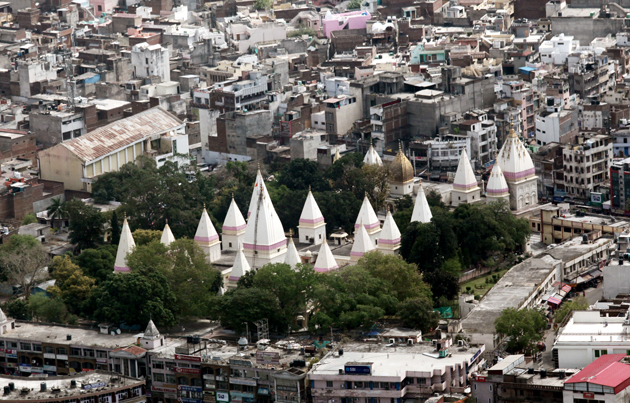Martand Singh
The royal families of Jammu including the Dogra dynasty have built and nurtured Hindu Temples in Jammu region since ancient times. Maharaja Gulab Singh and his son Maharaja Ranbir Singh were particularly famous for their contributions and dedication towards building Temples, preserving traditional customs of Hindu worship and promoting and nurturing Sanskrit scholars and manuscripts.
The jewel in the crown of Temples built by the Dogra Royals is the Sri Raghunath Ji Temple complex that is a cluster of twenty five temples along with a library of ancient rare manuscripts and a Paathshala which is spread across nearly seven acres in the heart of Jammu city. The building of this Temple was completed by Maharaja Ranbir Singh in 1857. The Dogra Royal Family has remained the custodian of these Temples since 1846 which is the year Maharaja Gulab Singh founded the state of Jammu & Kashmir along with the endowment of the Dharmarth Trust.
Fast-forwarding to the more contemporary history that is post-independence period in Jammu & Kashmir the scion of the Dogra royal family of Jammu & Kashmir, Dr. Karan Singh is a well-known statesman, philosopher, diplomat and philanthropist across the world. However, his notable contribution has also been which is not as well-known has been in building Temples and promoting Hinduism. Specifically in Jammu & Kashmir he concentrated upon the great Shri Raghunath Mandir, in which he made a number of additions and improvements.
Firstly, he added four new temples to the complex. The first was a Durga murti which was placed in a vacant marble temple and located directly behind the main Shri Raghunath temple and is known as Mata Vaishno Devi. The second is the unique Nataraja-Baglamukhi temple that Dr. Karan Singh built out of his own personal resources. He has deliberately kept it smaller than the other temples so as not to give the impression that he was competing with his ancestors. The temple itself contains statues of Ganesh, Nataraja and Mata Baglamukhi, specially made for the temple. A unique feature is the one metre high lead crystal shivaling which Dr. Karan Singh had fabricated in Germany. This unique shivaling is a great attraction for pilgrims. In addition to these two temples, Dr. Karan Singh had two rooms on either side of Maharaja Ranbir Singh ji’s samadhji which were being used as store rooms cleared, revealing that in fact both were designed to be temples. Dr. Karan Singh decided to complete the Shiva parivar by placing Mahakali on one side and Kartikeya on the other. These new murtis were ordered from Tamil Nadu and specially made to fit the size of the vacated rooms.
In addition to creating these new temples, Dr. Karan Singh has introduced the important concept of Utsav Murties as prevails in South India. There are two sets of utsavmurties – the one of Shri Ram, Sita, Lakshman and Hanuman is used for the important Vijaya Dashmi procession through the city, whereas the other Radha Krishna murties are placed in the chariot for the Janamashtmi procession. This is an innovation for North India and a great improvement because previously only Shaligrams or small shivalings were used on these occasions.
In the great Shri Ranbireshwar temple also he made important improvements, including adding two murtis in the outer court before entering the temple and replacing the small Nandi with a beautiful large metal Nandi acquired from Mysore. Here again the Utsav Murti of Lord Shiva has been provided for the annual Maha Shivratri procession. In Jammu he has also built a small samadhi for his mother Maharani Tara Devi in the complex where previous Maharani’s temple are located.
Beyond his home-state of Jammu & Kashmir, with his special interest in the great concept of Nataraja, Dr. Karan Singh has built a unique Nataraja temple near Pondicherry in the shape of a perfect pyramid. He has thus combined, for the first time, the sacred symbol of the ancient Egyptian, the pyramid, with the greatest representation of Indian sculpture – the Nataraja. This unique combination is visited by thousands of tourists every month and has become a tourist landmark in Pondicherry.
Moving further afield, he presented to a unique Hindu community in North Carolina, USA, a magnificent Nataraja which has been placed on a revolving mechanism so that it actually moves. The late Swami Sachidananda built a glass temple for it so that it can be viewed from afar.
All in all, apart from being a renowned Hindu scholar recognised throughout the world, who wrote the Foreword to the Hindu Encyclopaedia, Dr. Karan Singh has carried forward the legacy of his ancestors as the custodian of Temples and the Dharmarth Trust not only as a duty but with a particular personal interest, zeal and passion. In his capacity over the decades he has also extended support to many more Hindu and other socio-religious organisations in Jammu & Kashmir and across the country.


